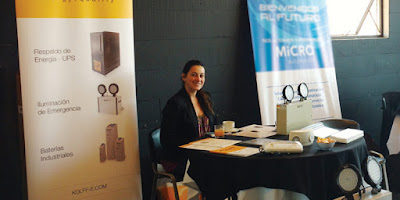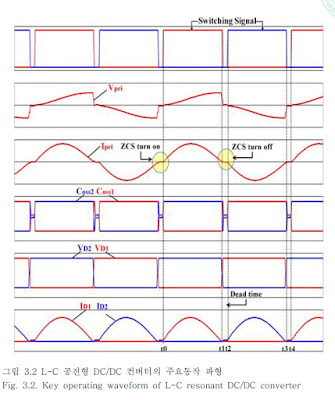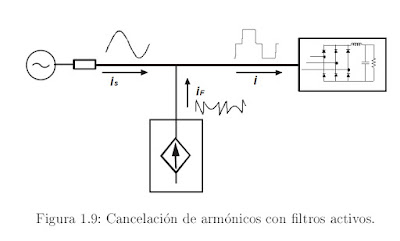domingo, 8 de janeiro de 2017
quarta-feira, 4 de janeiro de 2017
KOLFF en Expo Automatización 2016

Recientemente KOLFF participó en la 8ª Edición de la Expo Automatización realizada este año en la Sede San Joaquín de Duoc UC. En esta cita, llevada a cabo por la Asociación de la Industria Eléctrica, se contó con la presencia de destacados relatores del mundo tecnológico quienes entregaron sus conocimientos en variadas intervenciones enfocadas a la automatización en Chile. Entre los temas tratados se encontraron la eficiencia energética, las comunicaciones industriales y la robótica.
El stand de KOLFF destacó la relevancia de los equipos de respaldo eléctrico existentes en las empresas, y su eficiencia en la automatización de los sistemas de activación tras un corte del suministro energético.
LINK ORIGINAL EN LA WEB
terça-feira, 3 de janeiro de 2017
Design of a Power Converter for a Non-starting Air Conditioner Compressor in Commercial Vehicles - 상용차의 무시동시 에어컨 압축기용 전력변환기 설계 - Keun-Woo Han Department of Electrical Engineering Graduate, School Chonnam National University - SOUTH KOREA
Design of a Power Converter for a Non-starting Air Conditioner Compressor in Commercial Vehicles 상용차의 무시동시 에어컨 압축기용 전력변환기 설계
Keun-Woo Han
Department of Electrical Engineering Graduate, School Chonnam National University
(Abstract)
Recently, the direction of automotive technology development is concentrated on the reduction of the greenhouse gases accelerating global warming, as well as fuel efficiency improvement against rising oil prices. In particular, as a means of transportation with high transport efficiency compared to its vehicle market share, commercial vehicles are playing a key role in the national logistics industry. In addition, they also play an important role in all transportation sectors, supporting social overhead capital including urban construction, roads, bridges, harbors, etc. Consequently, their annual average mileage is 3.4 times that of passenger cars, with significant oil consumption or CO2 emission, which increases the need to develop eco-friendly technologies and increase energy efficiency. Commercial vehicles, which were recognized as a simple means of transportation in the past, have also become widely recognized as a second living space with the addition of space for the driver to sleep . Accordingly, existing commercial vehicle development is experiencing a change of direction from performance to the direction in which importance is placed on safety, comfort and convenience. The air conditioning system of a vehicle is a core component that maintains its interior temperature at a comfortable level according to the preference of passengers, and is of great significance in the aspect of increased comfort. In general, vehicle air conditioning systems refer to a unit that maintains a vehicle’s room temperature as desired by its driver using the energy generated by engine operation (driving or idling). Since the operation of such air conditioning systems utilize part of the engine’s driving force, it has s significant relation to the vehicle’s fuel efficiency. In particular, in the case of commercial vehicles, the utilization rate of an air conditioning system depends greatly on the driving habits of a driver when waiting for work during the summer season or when a driver frequently sleeps in the vehicle at night. Consequently, commercial vehicles which use air conditioners frequently and for long periods during the summer season need to have their large engines operating frequently, thereby causing environmental pollution due to excessive fuel consumption and exhaust gas. In addition, it is required that new vehicles must meet the Euro III Emission regulation and be equipped with a control system that automatically stops the engine when the vehicle remains idling for more than 5 minutes. Therefore, the problem regarding air conditioning (cooling) of commercial vehicles, including cargo vehicles and express buses, must be solved. This paper proposes a power converter for a non-starting air conditioner compressor for commercial vehicles in order to solve the problem of air conditioning (cooling) of a commercial vehicle when it remains stopped. The proposed system consists of a DC/DC converter and a 3 phase DC/AC inverter. In order for the air conditioning system to be operative in the non-starting state of the vehicle, an electrically driven compressor and 3 phase inverter operated at 200V and higher are required. However, in the case of a commercial vehicle, it is composed of a 24V battery-based DC system only. Therefore, in order to supply a non-starting air conditioner compressor system, a converter that can increase the voltage of the 24V battery by more than 10 times is indispensible. In the case of a converter for a non-starting air conditioner system, it requires high efficiency and high power density along with low voltage (24V) and high current characteristics. Therefore, a resonant type converter with an advantage of reduced loss due to high frequency switching is suitable for a power converter. In order to meet such conditions, this paper configured a L-C resonant type DC/DC converter with a half-bridge structure, consisting of a voltage doubler circuit and high frequency transformer. For the configured converter, the transformer leakage inductance and capacitor of the voltage doubler circuit are used for resonance without using an additional resonant tank. This enabled zero current switching (ZCS) to be available and also allows the converter to be designed in such a way that the switching loss at the primary side of the DC/DC converter transformer through which a current higher than 100A flows. In addition, the entire size and cost of the system were reduced by replacing the inductance component necessary for the resonant circuit with the transformer leakage inductance. As a result, unlike vehicles to which an existing mechanical compressor is applied, it can be seen that fuel consumption and exhaust gas emissions were reduced because no fuel was consumed separately during non-starting period. It is expected that the proposed power converter will ensure high efficiency under 24V low power supply conditions and be suitable for the power converter for similar air conditioner compressors for which a low withstanding voltage inverter module can be used.
domingo, 1 de janeiro de 2017
Control de filtros activos de potencia para la mitigación de armónicos y mejora del factor de potencia en sistemas desequilibrados-Author(s): Petit Suárez, Johann Farith- Universidad Carlos III de Madrid. Departamento de Ingeniería Eléctrica
Abstract: La utilización, cada día mayor, de dispositivos electrónicos en sectores residenciales, comerciales e industriales ha traído consigo un aumento significativo de las perturbaciones que afectan la calidad de la forma onda (distorsión armónica) y por ende a la degradación de ésta. El origen del problema en este caso está en la demanda de corrientes altamente distorsionadas que al propagarse por la red provocan caídas de tensión con un alto grado de distorsión armónica, aumento de pérdidas en las líneas eléctricas, malfuncionamiento de equipos, etc. Las soluciones existentes tratan de evitar que estas corrientes se propaguen por la red o en su defecto limitar la emisión de perturba¬ciones de forma que no afecte a la inmunidad electromagnética de los equipos o instalaciones conectadas a la red eléctrica. En esta tesis doctoral se presentan las bases conceptuales para implementar un filtro activo de potencia de conexión en paralelo (FAPP) para compensar esta perturbación y se propone un nuevo algoritmo para la generación de la corriente de referencia que busca extender el espectro de aplicación de estos filtros bajo tensiones de suministro desequilibradas y/o distorsionadas. Adicionalmente, se ha diseñado y construido un prototipo de FAPP que permite entre otras cosas el poder implementar los distintos algoritmos presentados en la literatura y verificar las capacidades que tiene este dispositivo para compensar perturbaciones de corriente en tiempo real
ABSTRACT
The wide application of the non-linear loads and electronics equipment such as adjustable speed drives, compact fluorescent lamps and personal computers in residential, commercial and industrial buildings, is directly responsible for the marked increase in the level of harmonic distortion observed in today's electrical power networks, producing an important and undesirable harmonic pollution problem. To mitigate the adverse impact of harmonic currents in electrical systems, compensators for such non-linear loads are needed and the active power filters appear like the dynamic solution that best fits the compensation necessities. In this PhD Thesis, the conceptual bases for a shunt active power filter (SAPF) implementation are presented and a new current reference algorithm for the SAPF control is proposed. The algorithm calculates the current reference to compénsate harmonics in the load current, load unbalances and the power factor under unbalanced and distorted voltages. Finally, the feasibility of the hardware implementation for the proposed current reference algorithm and other controls is evaluated in an experimental setup.
LINK ORIGINAL WEB
http://e-archivo.uc3m.es/handle/10016/2384#preview
LINK DIRECTO
http://hdl.handle.net/10016/2384
CONSIDERACIONES ACERCA DE LA UTILIZACIÓN DE ARROLLAMIENTOS DE ESTABILIZACIÓN EN TRANSFORMADORES ESTRELLA-ESTRELLA Autor: Ángel Ramos Gómez -TESIS DOCTORAL -DEPARTAMENTO DE INGENIERÍA ELÉCTRICA-UNIVERSIDAD CARLOS III DE MADRID
CONSIDERACIONES ACERCA DE LA UTILIZACIÓN DE ARROLLAMIENTOS DE ESTABILIZACIÓN EN TRANSFORMADORES ESTRELLA-ESTRELLA
Autor: Ángel Ramos Gómez
TESIS DOCTORAL -DEPARTAMENTO DE INGENIERÍA ELÉCTRICA
UNIVERSIDAD CARLOS III DE MADRID
LINK ORIGINAL EN LA WEB
http://e-archivo.uc3m.es/handle/10016/22747
LINK DIRECTO
http://e-archivo.uc3m.es/bitstream/handle/10016/22747/tesis_angel_ramos_gomez_2016.pdf?sequence=1&isAllowed=y
Autor: Ángel Ramos Gómez
TESIS DOCTORAL -DEPARTAMENTO DE INGENIERÍA ELÉCTRICA
UNIVERSIDAD CARLOS III DE MADRID
LINK ORIGINAL EN LA WEB
http://e-archivo.uc3m.es/handle/10016/22747
LINK DIRECTO
http://e-archivo.uc3m.es/bitstream/handle/10016/22747/tesis_angel_ramos_gomez_2016.pdf?sequence=1&isAllowed=y
Assinar:
Postagens (Atom)













































 JOSIL ARTISTA PLASTICO FORTALEZA CEARA BRASIL AV.HERACLITO GRAÇA 41 TEL(85)32542378
JOSIL ARTISTA PLASTICO FORTALEZA CEARA BRASIL AV.HERACLITO GRAÇA 41 TEL(85)32542378















